The current labor market is unlike anything America has ever experienced. It was also unfathomable, back at the start of the pandemic, that instead of a prolonged weak job market with few job opportunities and stagnant wages, there would be a record number of job openings and significant income gains beginning within just a year of the pandemic.
According to the most recent data, there were 10.4 million job openings in September 2021. This is a 38 percent increase (2.9 million more job openings) from the November 2018 pre-pandemic record, and it means that there were 2.8 million more job openings in September 2021 than there were unemployed workers. Workers are also quitting their jobs in droves, with a record-high 4.4 million quits in September. If that rate continues, it would mean that employers would have to replace one of three workers over the course of one year.
The labor shortage has created a damaging cycle: A lack of workers means that those with jobs often have to work overtime to pick up the slack, and often cannot take time off, which leads to unhappy workers, even more people quitting their jobs, increased instances of strikes, higher costs for employers (overtime pay and turnover costs), and, subsequently, even greater shortages of labor, goods, and services, with further price increases.
This Backgrounder examines what is happening in the labor market, considers the factors that may be holding workers back, and provides recommendations for policymakers to help encourage more productive work.
Employment Trends
At 155 million workers, total employment today is 3.1 million (1.9 percent) below its February 2020 level. Compared to a steady-state growth of about 84,000 jobs (0.53 percent) per month, total employment today is 4.7 million (3 percent) below where it might have been absent the pandemic and absent other changes in economic conditions.REF
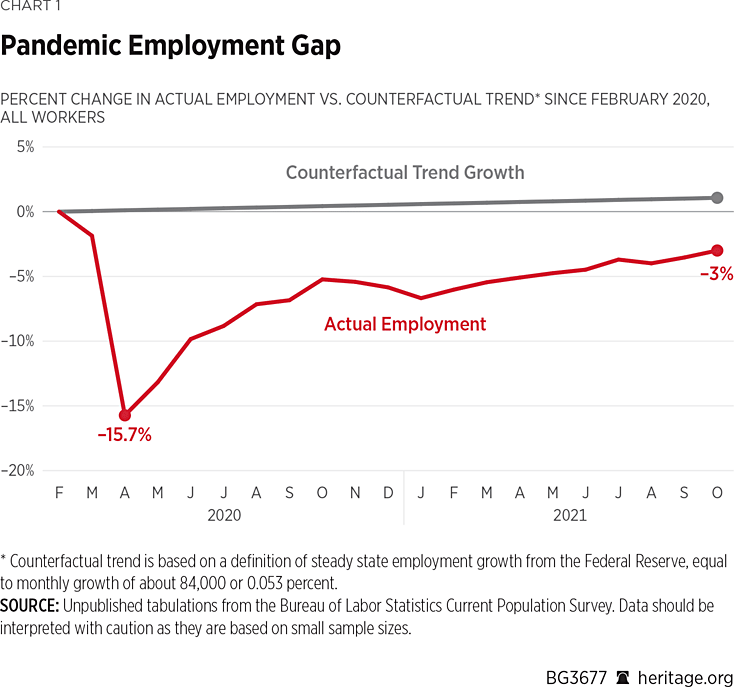
Throughout the pandemic, different groups of workers have been affected differently. Tabulations based on unpublished data from the Bureau of Labor Statistics’ Current Population Survey provide additional information on employment trends, such as by age, gender, and the presence of children in the home.REF Table 1 provides a breakdown of the employment gaps for various groups of workers, as measured by the percentage difference between current employment (October 2021) and where it would have been if, absent the pandemic, employment had followed steady-state employment growth.
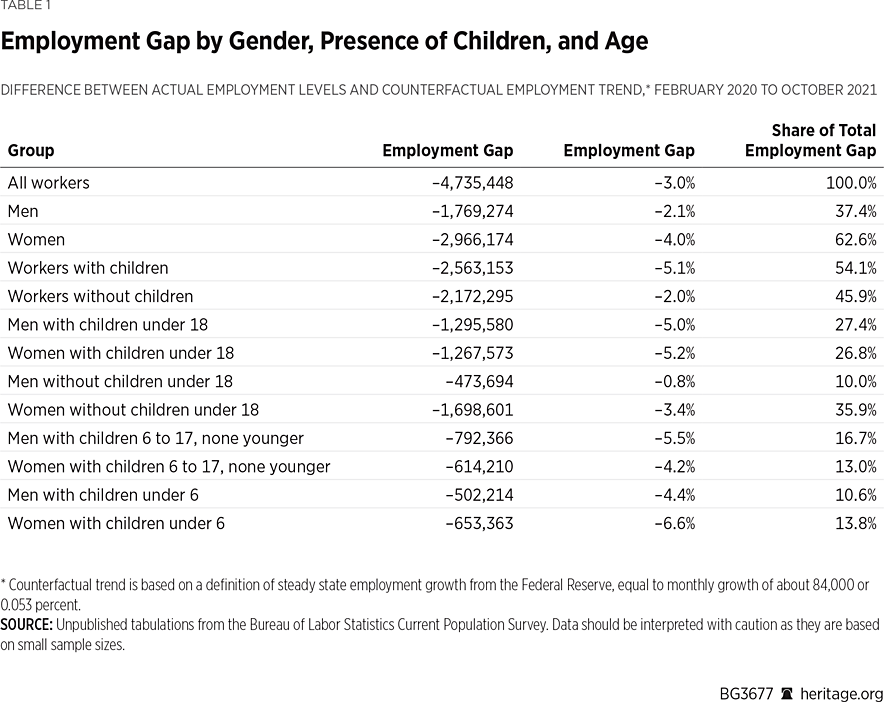
Men vs. Women. Initially, between February 2020 and April 2020, women’s employment declined by 2.2 million more than men’s, as women experienced an 18.1 percent employment gap and men experienced a 13.6 percent gap.REF The primary reasons that COVID-19 affected women disproportionately was that women made up a higher percentage of workers in the industries that were most impacted by COVID-19 shutdowns, and they also were more likely to be the primary caregivers for children whose schools and daycares had closed.
But men’s and women’s employment gaps narrowed through March 2021, at which point the women’s employment gap was 5.6 percent and the men’s was 5.3 percent.REF As men’s employment continued to rise and the men’s employment gap declined to 2.1 percent in October 2021, women’s employment gains leveled off throughout the spring and summer, but have ticked up recently, with their gap equal to 4.0 percent in October 2021.
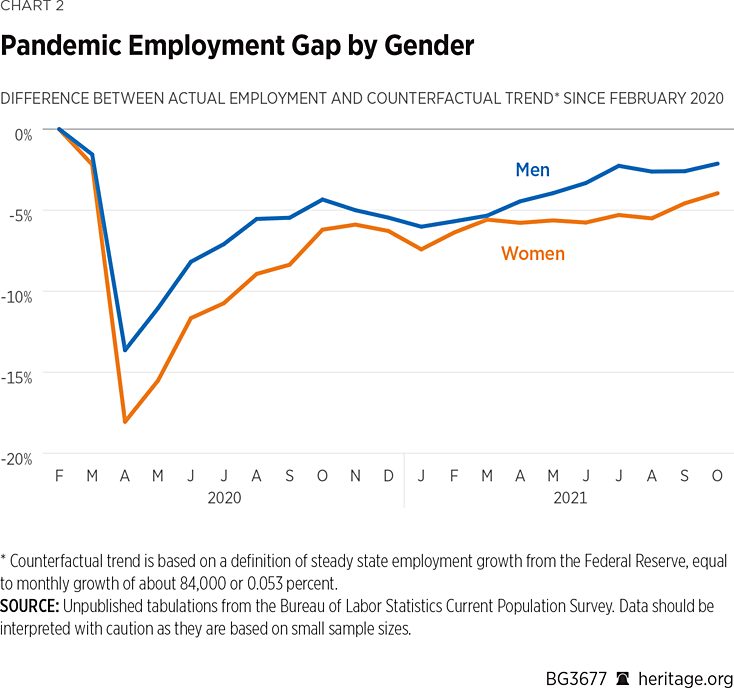
Although women’s employment recovery began to fall behind men’s in spring 2021, the fact that women’s unemployment rates were consistently well below men’s unemployment rates between September 2020 and September 2021 suggests that women’s employment shifts have more to do with their choices than with a lack of options.
Parents vs. Workers Without Children. Initially, parents’ employment fell by significantly less than that of non-parents, as the employment gap in April 2020 was 11.8 percent among parents and 17.6 percent among non-parents. (Parents are defined here as having one or more children under age 18 in the home.) This likely had to do with parents tending to have more seniority than younger, childless workers, and parents likely also have stronger desires for work—being less willing to quit and more likely to accept jobs—because of the need to provide for their children.
Parents consistently experienced lower employment gaps than non-parents until spring 2021, when that trend reversed. From March 2020 through February 2021, parents’ employment gap was 1.8 percentage points smaller than non-parents, but between March 2021 and October 2021, parents’ employment gap has been 2.1 percentage points higher than that of non-parents. As of October 2021, parents’ employment gap was 5.1 percent while non-parents’ was 2.0 percent. (See Chart 7 and discussion on child payments below.)
Older Americans. COVID-19 poses significantly higher risks for older individuals, and almost certainly contributed to older Americans’ larger employment losses. In April 2020, Americans ages 65 and older experienced a 19.9 percent employment gap, compared to a 13.5 percent gap among workers ages 25 through 54.REF
In addition to the health risks, all COVID-19 workplace adjustments (such as increased reliance on technology) may have contributed to older Americans’ decisions to withdraw from the labor force, especially for those with sufficient retirement savings. Following an initial sharp decline, the data show that older Americans’ employment rebounded throughout summer 2020 and was nearing the employment trends of prime-age workers in October 2020, but then declined alongside the late-fall 2020 and winter 2021 surge in COVID-19 cases, and then began rising in spring 2021 alongside vaccination availability. As of October 2021, the employment gap for workers ages 65 and older was 4.6 percent, compared to a 3.6 percent gap among workers ages 25 to 54.
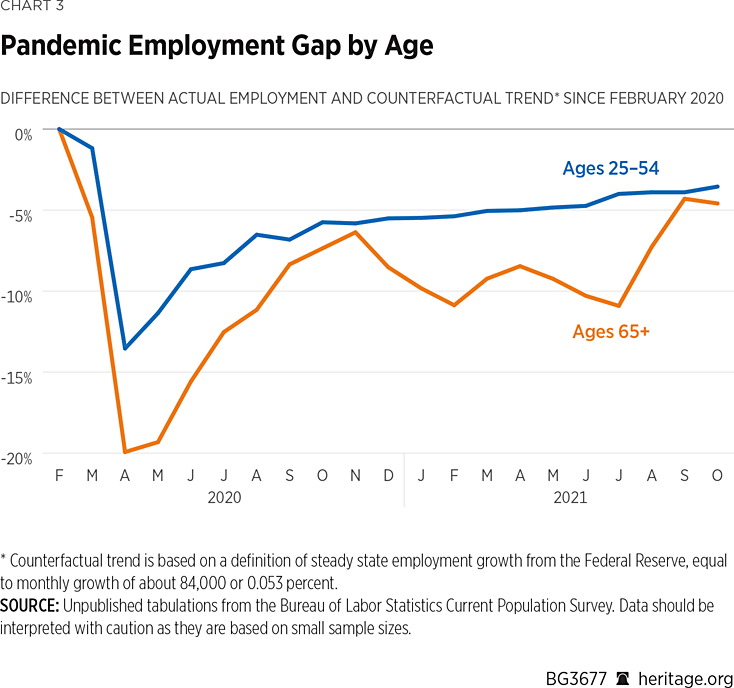
What Is Holding Workers Back?
With 10.4 million job openings—2.9 million more than the pre-pandemic record from November 2018—a lack of job opportunities is not the cause of low labor-force participation or sub-par employment.
Fear of COVID-19? While some workers—especially older Americans and individuals with health conditions that put them at greater risk from COVID-19—may be hesitant to return to work, the vaccine and significant health and safety precautions that are now commonplace have made it easier for individuals to protect themselves and to feel safer at work. The data indicate that fears of COVID-19 are not a significant factor in current labor shortages.
In May 2020, when the Bureau of Labor Statistics began collecting data related to the COVID-19 pandemic, there were 9.7 million individuals who were not in the labor force and not looking for work in the previous four weeks because of the coronavirus pandemic. This includes people who are fearful of catching the virus, as well as other pandemic-related reasons, such as a business closing or a change in circumstances related to COVID-19.
The number of people not looking for work because of the pandemic quickly declined to 3.6 million in October 2020, and then began rising again amid the second, fall 2020, wave of COVID-19 infections. Between January and June 2021, the number of individuals not looking for work because of COVID-19 steadily declined from 4.7 million to 1.6 million as vaccines became widely available. This figure remained stable around 1.6 million individuals through September 2021 and dipped to 1.3 million in October 2021.
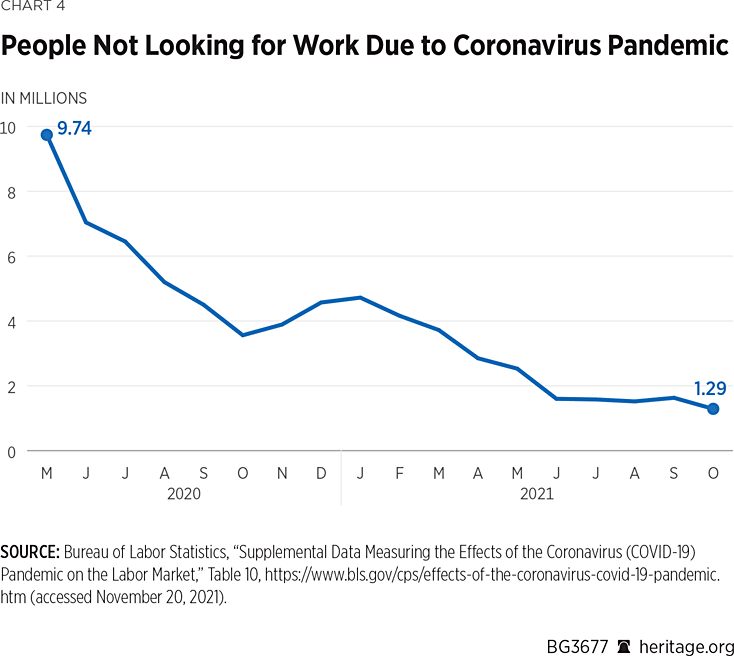
Compared to 10.4 million job openings, 1.3 million individuals not looking for work because of COVID-19 is a relatively small factor in the labor shortage.
Childcare Struggles? Childcare is a logical source of potential employment struggles for parents amidst COVID-19, especially in spring 2020 when 13 percent of working parents reported cutting back on work hours or quitting a job because of a lack of childcare.REF
But childcare providers were generally quicker to reopen than public schools, and while some issues, such as the unprecedented labor shortage and COVID-19 protocols, are still affecting the reliability of childcare, it does not appear that access to childcare is a new struggle. A May 2021 study by Jason Furman (former chair of President Barack Obama’s Council of Economic Advisers), Melissa Kearney, and Wilson Powell III found that childcare struggles have had little or no impact on the jobs recovery. The authors found that “despite the widespread challenges that parents across the country have faced from ongoing school and daycare closures, excess employment declines among parents of young children are not a driver of continuing low employment levels.”REF In fact, parents’ employment declined by 4.5 percent, compared to a 5.2 percent decline in employment among workers who are not parents of young children.
While the employment of fathers declined by even less than that of mothers, the authors found that “any childcare issues that have pushed mothers out of the workforce account for a negligible share of the overall reduction in employment since the beginning of the pandemic,” and noted that the impact was “zero, in fact” after controlling for factors like education and industry.REF
Yet, that report was published in May 2021, presumably using data from March or April, and as Chart 7 and Table 1comparing workers with and without children both show, there has been a shift since then. It seems unlikely that childcare struggles would have markedly increased more than a year after the pandemic began.
A comparison of employment gaps among workers with young, childcare-age children versus parents with older, school-aged children could help to tease out the role of childcare. Table 1 shows that the employment gap among fathers with children under age six (childcare-aged)—at 4.4 percent—is actually smaller than the 5.5 percent employment gap among fathers with children ages six through 17. The reverse is true for women; mothers with children under age six have a 6.6 percent employment gap, while mothers with children ages six through 17 have a 4.2 percent gap.
Possible explanations for parents’ employment trends include the availability of in-person schooling (parents’ employment rose in fall 2020 as some schools reopened in person, and experienced a small boost in fall 2021), and disruptions in childcare, with labor shortages and COVID-19 health protocols sometimes limiting capacity and causing temporary closures. There also may be parent-motivated choices affecting employment, including decisions to spend more time at home with children, deciding to homeschool, and the introduction of monthly vs making it easier not to work. The potential impact of monthly child payments is discussed below and visualized in Chart 7.
Welfare-Without-Work Policies: Tipping the Scale Away from Work
Maximum employment requires not only that it pay to work, but also that it not pay to not work. Wages have been rising and workplace benefits have expanded (though high levels of inflation have reduced the value of wage gains). According to a September 2021 survey from the National Federation of Independent Business, a record-high 42 percent of employers reported compensation increases in September, and 30 percent said they planned to increase compensation over the following three months.REF All else equal, compensation increases should cause more people to work, not fewer.
On the other side of the ledger, however, various government programs and policies enacted in the name of COVID-19 have made it easier for people to not work, and almost certainly continue to play a role in weak employment. A measure called the reservation wage, which is the lowest wage at which individuals will accept a job, can help to determine the impact of added welfare benefits on people’s willingness to work.
According to the Federal Reserve Bank of New York, workers’ overall reservation wage increased by 15.7 percent between March 2020 and July 2021, from $61,737 to $68,954. (Inflation, as measured by the personal consumption expenditures index (PCE), increased by 14.8 percent during this time.) Lower-wage workers, for whom welfare benefits played a bigger role, experienced large swings in their reservation wages, with the pattern indicating a strong impact from government cash and welfare benefits.
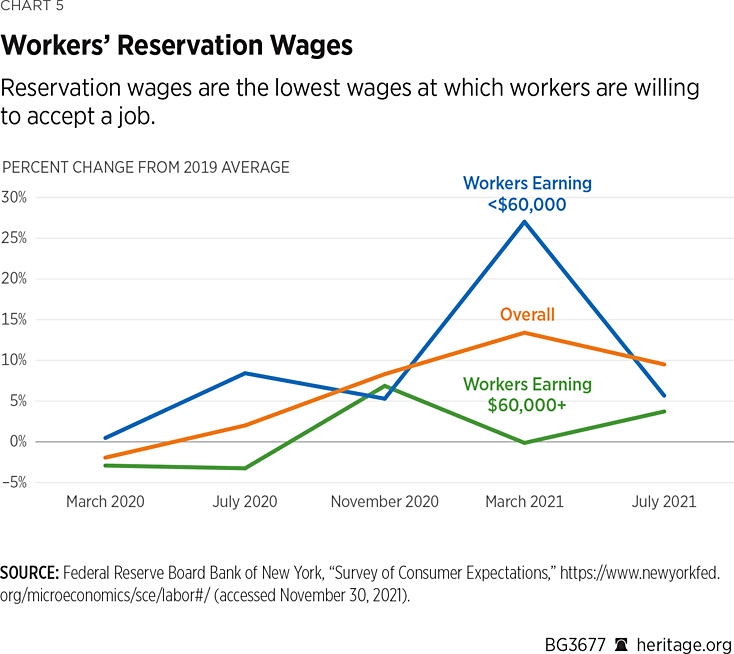
Between March 2020 and March 2021, the reservation wage for workers making less than $60,000 increased by 26.4 percent, from $40,197 to $50,825. (During the same period, the PCE increased 12.3 percent.) Between March 2021 and July 2021, lower-wage workers’ reservation wage fell sharply, declining by $8,547 (16.8 percent) to $42,278 over just three months. That stark change coincided with the end of some major COVID-19 programs, including the eviction moratorium and about half the states deciding to end the COVID-19 unemployment insurance bonus payments.REF
A Heritage Foundation analysis of the recent growth in welfare benefits reported that “[i]n 2018, before the COVID-19 pandemic, the average family with children that was defined as poor by the government received $20,700 in cash, food and housing benefits and another $17,000 in medical care and $5,000 in social services.”REF In addition to that $42,700 in combined benefits, “[t]he Build Back Better Act would add another $11,300 in annual benefits to the average poor family,” bringing the total welfare assistance to $54,000.REF
While it is too soon to know the precise impact of various government welfare programs on the current labor market, evidence from past studies of welfare benefits and some recent data suggest that some of the pandemic policies mentioned below have reduced the supply of willing workers.
18 Months of Generous Unemployment Benefits. Economic studies consistently show that higher benefit levels and longer durations of benefits lead to higher levels of claims and longer periods of unemployment. The additional $600 per week in bonus unemployment insurance benefits that lasted between March and December 2020 created a disincentive to return to workREF as two-thirds of unemployed workers were receiving more from unemployment benefits than from their previous paychecks.REF Though not as large of an effect, the additional $300 in benefits from March 2021 through the beginning of September 2021REF also reduced the incentive to work. Moreover, the extension of unemployment benefits to nearly all workers, including for reasons other than being laid off through no fault of their own, also discouraged work.
Examples from employers across the country, and employment data, confirm the negative impact of extended and bonus unemployment insurance benefits on employment.REF
Analysis by Casey Mulligan shows that states that ended the unemployment insurance bonuses in July 2021 or earlier experienced a significantly greater pace of employment recovery in July and August than states that did not end the benefits until the beginning of September. If the states that did not end unemployment insurance bonus payments early had recovered at the same rate as states that did end the payments early, the economy would have experienced 800,000 more job gains in July and August.REF
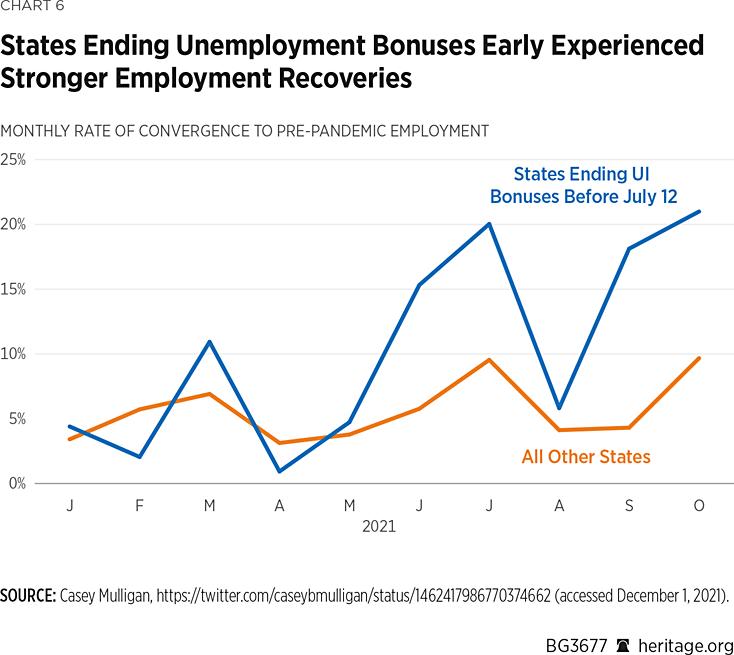
Expanded Obamacare Subsidies. Employer-provided health insurance incentivizes work through the value it provides in health insurance, as well as the effective price reduction that comes through the tax deduction for employer-provided health insurance. For many people, having health insurance is a significant reason why they work.
Obamacare is an alternative way for certain people to get non-employer-provided health insurance, with this alternative being more valuable to lower-income earners and less appealing to higher-income earners. Obamacare subsidies are equally available without regard to work participation, though they decrease in value as individuals work and earn more. The American Rescue Plan (ARP) significantly reduced the share of income that individuals must pay toward Obamacare premiums so that anyone making below 150 percent of the federal poverty level (FPL; equal to about $13,000 for a single person and $26,500 for a family of four) now pays nothing for health insurance. Households making 300 percent of the FPL (about $39,000 for a single person and about $80,000 for a family of four) pay no more than 6 percent of their income for health insurance.
Obamacare subsidies can deter individuals from accepting a job that could result in the loss of their Obamacare benefits, and can deter them from working more hours because the higher premium amounts act as an additional tax on work.
Monthly Child Payments. Although it is too soon to determine a causal relationship, parents’ employment stopped recovering—even declined—at the same time that monthly child payments, equaling $300 per month for children ages five and younger and $250 per month for children ages six through 17, began.
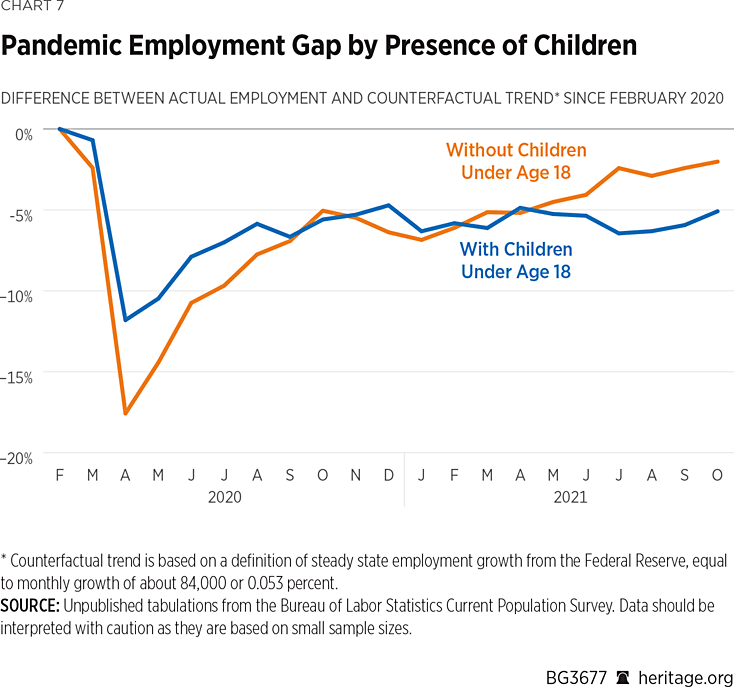
The fact that these payments—unlike the previous child tax credit—are not conditional on work means that they make it easier for families to afford the things they need and want with less work. In this way, the payments could be a reason why parents’ employment leveled off and even declined slightly starting this spring, while non-parents’ employment continued to rise.
A study by researchers at the University of Chicago estimated that making the child payments permanent would reduce the labor-force participation and employment of parents by 2.6 percent, which is 1.5 million workers.REF Another troubling part of the analysis comes from the finding that despite providing an additional $3,000 to $3,600 per year, per child, the payments would have zero impact on deep childhood poverty. Having at least one working adult in the home is crucial to breaking cycles of poverty, and this finding implies that a significant number of parents in low-income and single-parent households would drop out of the labor force entirely.
Supplemental Nutrition Assistance Program (SNAP) Benefit Increases. In response to the pandemic, policymakers substantially increased SNAP food stamp benefits, and President Joe Biden approved an even greater and permanent increase in SNAP benefits—the largest increase in history—in October 2021. Between fiscal year (FY) 2019 and FY 2021, the number of SNAP recipients increased by 6.1 million, 17 percent, and per-person monthly benefits increased by $84—a 65 percent increase that translates into an extra $4,000 per year for a family of four.REF An economic analysis of the introduction of food stamps found that it reduced employment and incomes, with the largest employment declines among single mothers (who reduced their work by an average of 183 hours per year).REF Moreover, the Penn Wharton Budget Model estimates that increased SNAP benefits will lead to lower employment and reduced long-run wages, with increased benefits providing only 28 cents for every $1.00 taken out of the economy.REF
Eviction Moratorium and Rental Assistance. Various federal, state, and local programs provided housing assistance in the form of COVID-19 rental assistance programs, and the Centers for Disease Control and Prevention’s (CDC’s) eviction moratorium allowed millions of Americans to forego their rent payments with little or no consequence (which has since been declared unlawful by the courts).REF Since housing is most Americans’ greatest expense, programs that paid all or part of people’s rent and mortgages, or temporarily exonerated them from the consequences of not paying their rent, made it easier for them to not work. Future economic studies will likely show that individuals who received rental assistance or did not pay their rent because of the eviction moratorium stayed out of work longer than did unemployed workers who did not, or could not, access these programs.
Economic Stimulus Payments. Between April 2020 and May 2021, most households in America received three rounds of “economic stimulus” payments that provided $11,400 total to a typical family of four. While these payments did not proactively discourage employment in the way that conditional benefits like unemployment insurance and SNAP did, the windfall of cash nevertheless made it easier for some people to work less or remain unemployed longer than they otherwise could.
In total, the accumulation of so-called COVID-19 relief measures contributed to Americans saving $2.2 trillion more in the year following the pandemic than they did in the year prior to the pandemic ($3.5 trillion vs. $1.3 trillion).REF These savings and ongoing expansions in government benefits are almost certainly weighing on individuals’ work decisions. Analysis of the impact of welfare cash-assistance programs showed that $1,000 of cash benefits were associated with a $660 reduction in earnings.REF A similar study found that each $1 of government benefits resulted in a $5 decline in lifetime income.REF To the extent that COVID-19 benefits shifted reliance away from work and toward government transfers, this could have long-term consequences on lifetime employment and incomes.REF
Vaccine Mandates
In addition to some state and local vaccine mandates for certain public-sector employees, the Biden Administration has issued various federal vaccine mandates, or vaccine-and-testing mandates, that could apply to a majority of U.S. workers, with the potential to reduce employment in the U.S. significantly. These include a vaccine mandate now in effect for roughly 3.5 million federal employees, a Centers for Medicare and Medicaid Services vaccine mandate that applies to roughly 14 million workers at health care facilities that provide Medicare and Medicaid services (scheduled to take effect January 4, 2022); and an Occupational Safety and Health Administration (OSHA) vaccine-and-testing mandate that would apply to about 84 million workers (scheduled to take effect January 4, 2022, but currently under a court-ordered injunction).
As of late November 21, 2021, 33.2 percent of Americans ages 18 to 64 were not fully vaccinated.REF Many of those individuals are strongly opposed to getting vaccinated and may be willing to be fired from their jobs to avoid getting vaccinated. An October 2021 “Vaccine Monitor” survey from the Kaiser Family Foundation reported that “[m]ore than a third (37%) of unvaccinated workers (5% of adults overall) say they would leave their job if their employer required them to get a vaccine or get tested weekly, a share that rises to seven in ten unvaccinated workers (9% of all adults) if weekly testing is not an option.”REF
Already, state and local vaccine mandates have caused thousands of workers to lose their jobs. In New York, the state’s largest health care provider, Northwell Health, had to lay off 1,400 workers—nearly 2 percent of its workforce.REF New York City had to put about 1,800 school safety agents and 2,000 teachers on unpaid leave when the city’s COVID-19 vaccine mandate went into effect.REF With many police unions opposing the vaccine mandate, and some forces, such as the Los Angeles Police Department, having about 40 percent of its force unvaccinated a few weeks before an October 20 deadline, enforcing the mandate could mean widespread layoffs—and public safety risks.REF
According to the Federal Reserve’s October 2021 Beige Book, vaccine mandates are contributing to high turnover and production slowdowns. While the number of quits due to the mandate is expected to be relatively small, the Fed noted that “federal vaccine mandates were expected to exacerbate labor problems.”REF
The federal government’s vaccine mandate for federal employees went into effect on November 22,REF with the White House reporting that of 3.5 million federal workers, 90 percent had been vaccinated and another 5 percent were seeking exemptions or extensions.REF That leaves at least 5 percent, about 175,000 federal workers, who will likely be laid off and need to be replaced. Considering that it takes an average of 98 days to hire a federal worker (often more than a year for positions that require security clearances) and months to fully train them, this could lead to significant delays in some federal services, and failure to perform other services.REF
The federal government’s vaccine mandate for Medicare and Medicaid providers extends to about 14 million workers. The vaccine mandate for federal contractors, which was postponed until January 4, 2022, would affect about 5 million people. And if implemented, the OSHA emergency temporary standard could affect 84 million workers. Currently, a stay issued by the Fifth Circuit Court is preventing OSHA from taking any further steps to implement or enforce the vaccine mandate. Considering that Congress never gave OSHA the authority to require the use of vaccines as a condition of providing a safe workplace, it is unlikely that the OSHA mandate will take effect.REF
The imposition of vaccine mandates on roughly 20 million federal employees, federal contractors, and Medicare and Medicaid providers, along with separate state and local public-sector vaccine mandates will likely reduce employment over the coming months. The good news for workers who do not want to get vaccinated is that record-high job openings mean it will be easier to find a new job, though not all public-sector jobs are easily transferrable to the private sector. The bad news for Americans, however, is that government vaccine mandates could threaten the safety of Americans through the loss of military, police, and firefighters. And, mandates could harm the well-being of children and families as they affect schools, transportation, and other government services.
Policies to Encourage Work
The more people benefit from working, the more work they will perform, and how much people benefit from work depends on the benefits they receive from working and not working. Thus, increasing labor-force participation and employment requires not only making work more attractive and easier to obtain, but also making not working and relying on the incomes of others less attractive.
Making Work Pay—Spurring Productivity Gains. Higher wages generally prompt people to work more. The only ways to achieve lasting wage increases are through education and experience and technological investments that make workers more productive. Policymakers should make it easier to obtain income-enhancing education and skills, including through less expensive options, such as apprenticeship programs. Reducing or eliminating double taxes on investments would lead to greater productivity and wage-enhancing investments.
Making Work Pay—Lowering Taxes. If one taxes something, one gets less of it. So, taxes on work generally result in less work. This can be particularly true at lower-income levels where a litany of different welfare benefits and phase-outs can lead to very high marginal tax rates. A Congressional Budget Office review of the economic literature found that lower-income workers eligible for the earned-income tax credit had very high labor-force participation elasticities in the range of 0.3 to 1.2, meaning that a one-percentage-point increase in after-tax wages caused them to increase their work by 0.3 percent to 1.2 percent.REF With Americans already paying more in taxes than they do on housing, clothing, and food combined, and with many of those expenses provided through welfare if individuals restrict their work, tax cuts on wages could help to increase work.REF
Making Work Pay—Opening Doors to Work Opportunities. Workers value autonomy and flexibility, as demonstrated by recent growth in independent work in the U.S. According to a study commissioned by UpWork, 36 percent of the total U.S. workforce participated in independent work, or freelancing, in 2020, and 12 percent of all workers started freelance work during the pandemic.REF Greater autonomy translates into greater labor-force participation and more hours of work. For example, a study of Uber drivers found that the average driver works 16 hours per week when provided a fully-flexible work platform, but would not work at all if required to commit to a rigid schedule through a taxi cab platform.REF Policymakers should not enact laws that prohibit companies from doing business with independent workers, and should clarify the definition of “employee” across federal laws according to the level of control the individual maintains over his work.
Fewer Regulations, Lower Taxes on Employers. By driving up the cost of doing business, higher corporate taxes and unnecessary regulations leave less money to raise workers’ wages. The Tax Cuts and Jobs Act reduced the top corporate tax rate from 35 percent to 21 percent, and a series of reductions in unnecessary and burdensome regulations helped businesses to expand, including by hiring more workers and increasing compensation. Prior to these changes, wage growth had been declining. That trend quickly reversed, and wages rose at above-trend rates following the tax cuts. A study by former Heritage Foundation analyst Adam Michel found that the shift in wage growth translated to an additional $1,406 of annualized earnings above the previous trend for the average production and non-supervisory worker as of March 2020.REF Expanding employment opportunities and rising wages help to maximize employment.
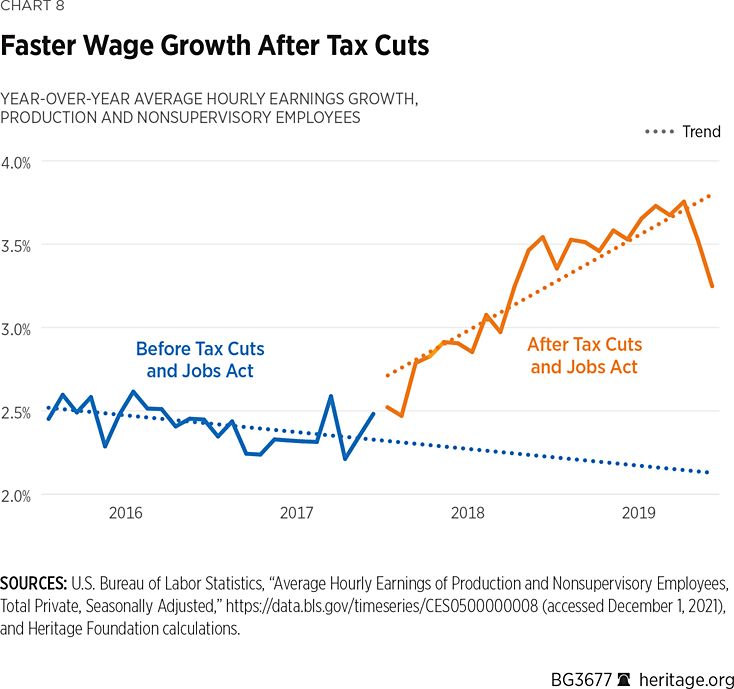
Work-Oriented Welfare. Work is crucial to breaking cycles of poverty and dependence. When President Bill Clinton signed the historic, bipartisan welfare reform package in 1996, he talked about how many people in America had been “trapped on welfare for a very long time, exiling them from the entire community of work that gives structure to our lives.”REF He quoted Robert Kennedy, who had declared: “Work is the meaning of what this country is all about. We need it as individuals, we need to sense it in our fellow citizens and we need it as a society and as a people.”REF
Growth in welfare since the 1996 reforms, COVID-19-relief expansions, and the proposed creation of cradle-to-grave welfare benefits will reduce work and individual well-being. Instead of measuring the success of government welfare programs by how many people they serve—including drawing in even those who are not in need—the primary goal of welfare should be to help individuals and families to thrive. That can only happen if they are empowered, through work, to earn a living that allows them to make their own decisions and pursue their own goals. Welfare programs for work-capable individuals must be tied to work.
Reforming Disability Insurance (DI) to Encourage Rehabilitation. DI is one welfare program that is specifically designed for individuals who are not capable of work. For a variety of reasons—including technological and medical advancements and changes in the way that people work—most individuals’ ability to work is not black or white. Yet, the DI program largely functions in black and white—benefits or no benefits—and it fails to do anything to help workers regain work capacity. In fact, it can actually hinder work capabilities through a lengthy disability determination process followed by a two-year waiting period for Medicare benefits. Private long-term disability insurance, which invests in rehabilitation and workplace accommodations, boasts nearly four times the recovery and return-to-work rate as the federal DI program.REF Policymakers should reform the DI program to better serve individuals in need, and to improve pathways back to work for those who are capable of full or partial recovery.REF
Integrated Workforce Services. Part of the reason why federal workforce programs fail to significantly improve outcomes is that they are scattered across 47 different programs and multiple agencies.REF Policymakers should integrate welfare and work programs so that individuals in need can walk through “one door” (or at least fewer doors) to get connected with the services they need.REF
Accessible, More Affordable Childcare. Childcare is critical for parents of young children who want or need to work, but it needs to be the type of care that parents want. While state and local lawmakers can help to reduce costs and expand supply by eliminating costly regulations that do not improve safety and quality of care, federal lawmakers should help to expand options for lower-income families by allowing families to use federal childcare subsidies and Head Start funds at a provider of their choice. Not only does Head Start have lackluster outcomes, but its limited hours of operation—effectively a preschool program—mean that it is often not a viable childcare solution for working parents.REF
Flexible, Accommodating Paid Family Leave. Paid family leave is incredibly valuable and can help to increase labor-force participation, but one-size-fits-all paid family leave cannot meet workers’ and employers’ unique needs as well as more flexible and accommodating employer-provided policies. To help build upon the 64 percent increase in access to paid family leave that has occurred over the past five years,REF policymakers should allow lower-wage, hourly workers to choose between paid time off and extra pay for the overtime.REF Senator Mike Lee’s (R–UT) Working Families Flexibility Act would do just this. Moreover, policymakers could clarify that employers are allowed (but not required) to auto-enroll their workers in private disability insurance programs, which provide benefits that cover the majority of workers’ needs for leave.
Portable Benefits. The average worker will change jobs 12 times throughout her career. That can mean changing health insurance 12 times, and either having to roll over retirement accounts or managing many different accounts. Moreover, an increasing number of individuals are choosing to work independently, but that typically means they lack access to less-expensive group-based health insurance, disability insurance, and retirement savings accounts. To help more individuals to pursue the work opportunities that are best for them, policymakers should expand the concept of association health plans so that workers can more easily access other portable benefits that meet their needs.
Removing Social Security Disincentives to Work at Older Ages. Significant medical improvements, less physically demanding jobs, and increasing life spans mean that most Americans can work longer than previous generations, making positive contributions to the economy and boosting their and their family’s financial well-being.REF The majority of Americans claim Social Security benefits before they reach Social Security’s normal retirement age, and by doing so, they are subject to Social Security’s retirement earnings test that takes away 50 cents of every dollar they earn above about $19,000 until they reach normal retirement age (currently 66 and 10 months). Although benefits are later adjusted upwards to effectively give back these taxes, workers perceive the test as a 50 percent tax and thus it serves as a significant deterrent to work after claiming Social Security benefits. (Though the program’s looming insolvency and Americans’ uncertainty over their life expectancy encourage many to claim benefits early.) Policymakers should let workers opt out of the Social Security earnings test, which would not only encourage more work at older ages, but could generate Social Security savings.REF
Other reforms that would make it more advantageous for older Americans to work include shifting Social Security’s benefit formula so that workers would accrue benefits based on each year they work, as opposed to averaging their benefits across all years (which disproportionately benefits high earners with fewer years of work),REF and allowing workers the option to receive a lump-sum delayed retirement credit.REF
Rejecting the Build Back Better Package. The massive social spending package that seeks to transform the economy through central planning would almost universally weaken the labor market, sustain existing supply-chain struggles, and further fuel inflationary pressures. By taxing productive activities, by subsidizing unproductive activities through welfare-without-work benefits, by propping up unions at the expense of small businesses and independent workers, by wasting money on ineffective federal job-training programs, by attempting to micromanage private companies, and by imposing environmental and labor restrictions similar to those fueling the logjam at California’s ports, the massive tax-and-spend package will weaken the labor market. A study from the Texas Public Policy Foundation estimated that a similar version of the current reconciliation package would reduce employment by 5.3 million jobs, REF while Casey Mulligan estimated an even larger employment loss of 8.7 million jobs.REF
Conclusion
Today’s employment market is unlike any other in history. Never before has America experienced a labor shortage of today’s magnitude, and particularly extraordinary is that the current labor shortage exists alongside still-elevated unemployment and improved compensation packages that should spur more workers into jobs. Today’s employment gap equals about 4.7 million workers, which is 3.0 percent of the workforce. Some notable employment trends include a recent decline in the employment recoveries of women and of parents, beginning in spring 2021.
While some factors related to the pandemic—such as lingering COVID-19 health concerns, and some parents’ changed preferences for homeschooling or spending more time caring for young children—have reduced employment, these factors can only explain a relatively small portion of the 5.8 million employment gap. Future economic analysis will help to explain the role of various factors in the current employment gap, but it appears that government policies enacted in the name of COVID-19 relief have consistently held employment back, and the multitrillion-dollar tax-and-spend, central-planning package threatens to cement a weak employment market into the future.
To encourage Americans to pursue their productive capabilities, policymakers should ensure that work pays—by limiting taxes, enabling larger natural wage increases, and opening more doors to flexible income opportunities. On the other side of the equation, policymakers need to remove work disincentives from America’s entitlement and welfare programs to improve individual and societal well-being. Finally, policymakers should learn from the unintended impacts of many COVID-19 policies that have reduced employment, and should refrain from further expanding or making permanent the programs and policies that have contributed to the current employment gap.
Rachel Greszler is Research Fellow in Economics, the Budget, and Entitlements in the Grover M. Hermann Center for the Federal Budget, of the Institute for Economic Freedom, at The Heritage Foundation.



